|
The Magic of Light
by Bob Brooke
Back in the 17th century, entertainment was limited to live musical and
theatrical performances. But the invention of a magical device that
projected images on a white wall or muslin screen changed all that and
entertain would never be the same. That invention was the “magic
lantern.”
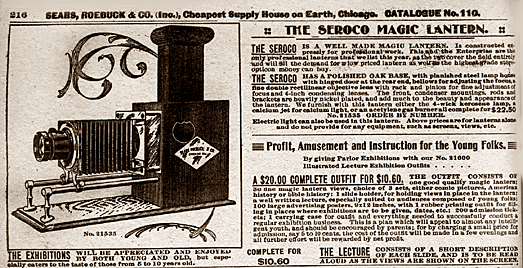
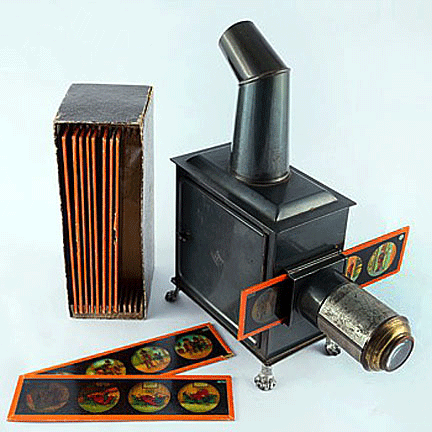 Though
several types of projecting systems had existed before the invention of
the magic lantern, none worked well enough to really catch the public’s
eye. Though
several types of projecting systems had existed before the invention of
the magic lantern, none worked well enough to really catch the public’s
eye.
The magic lantern, also known by its Latin name laterna magica,
coined by Thomas Rasmussen Walgensten, a 17th-century mathematician from
Gotland, Sweden, was an early type of image projector that used
pictures—paintings, prints, and later photographs—on transparent glass
plates, one or more lenses, and a light source.
The name “magic lantern” comes from the experience of the early
audiences who saw devils and angels mysteriously appear on the wall, as
if by magic. Even in the earliest period, performances contained images
that moved—created with moving pieces of glass.
The Invention of the Magic Lantern
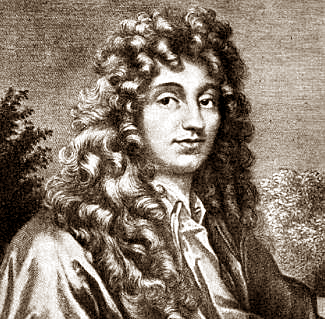 Most
historians credit Dutch scientist Christiaan Huygens as the inventor of
the magic lantern. He knew of Athanasius Kircher's 1645 edition of Ars
Magna Lucis et Umbrae which described a primitive projection system with
a focusing lens and text or pictures painted on a concave mirror
reflecting sunlight. Christiaan's father Constantijn had been acquainted
with Cornelis Drebbel who used some unidentified optical techniques to
transform himself and to summon wonderful appearances in magical
performances. Most
historians credit Dutch scientist Christiaan Huygens as the inventor of
the magic lantern. He knew of Athanasius Kircher's 1645 edition of Ars
Magna Lucis et Umbrae which described a primitive projection system with
a focusing lens and text or pictures painted on a concave mirror
reflecting sunlight. Christiaan's father Constantijn had been acquainted
with Cornelis Drebbel who used some unidentified optical techniques to
transform himself and to summon wonderful appearances in magical
performances.
But like other scientists of his day, Huygens thought it was too
frivolous. In a 1662, he wrote his brother Lodewijk, claiming that his
invention would harm the family's reputation if people found out the
lantern came from him. Christiaan initially referred to the magic
lantern as "la lampe" and "la lanterne", but later
referred to it as the "laterna magica.”
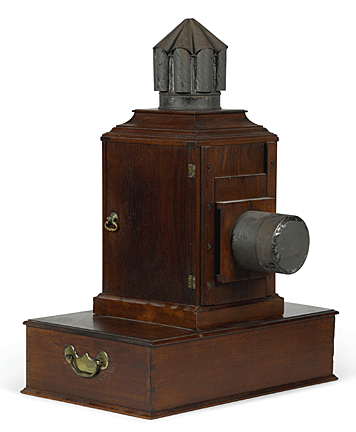 In
1664 Parisian engineer Pierre Petit wrote to Huygens to ask for some
specifications of his lantern, because he was trying to construct one
with a concave mirror behind the lamp. This directed more light through
the lens, resulting in a brighter projection, and it would become a
standard part of most of the lanterns that were made later. Petit
boasted that he made a lamp stronger than any he had ever seen. In
1664 Parisian engineer Pierre Petit wrote to Huygens to ask for some
specifications of his lantern, because he was trying to construct one
with a concave mirror behind the lamp. This directed more light through
the lens, resulting in a brighter projection, and it would become a
standard part of most of the lanterns that were made later. Petit
boasted that he made a lamp stronger than any he had ever seen.
From then on, magic lanterns used a concave mirror behind a light source
to direct the light through a small rectangular sheet of glass—a
"lantern slide" that bore the image—and onward into a lens at the front
of the apparatus. The lens adjusted to focus the plane of the slide at
the distance of the projection screen, which could be simply a white
wall, and it therefore formed an enlarged image of the slide on the
screen. Some lanterns, including the one invented by Huygens used three
lenses.
Magic Lantern Slides
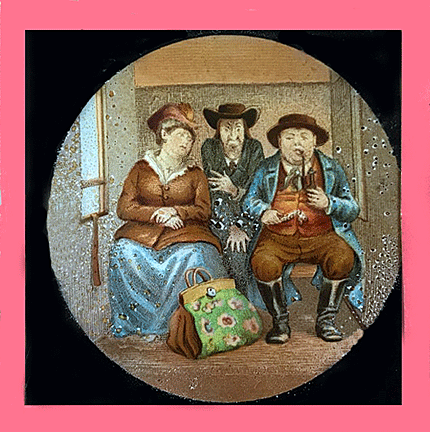 Ernst
Wilhelm and Friedrich Langenheim, German-born brothers in Philadelphia,
invented the first photographic lantern slides, called hyalotypes, and
patented them in 1850. Ernst
Wilhelm and Friedrich Langenheim, German-born brothers in Philadelphia,
invented the first photographic lantern slides, called hyalotypes, and
patented them in 1850.
Originally hand painted on glass slides, these “sliders,” as they called
them, featured figures rendered with black paint. Soon the brothers also
used transparent colors. Sometimes they did the painting on oiled paper,
using black paint as a background to block superfluous light, so the
figures could be projected without distracting borders or frames. They
finished many of their slides with a layer of transparent lacquer, but
later used cover glasses to protect the painted layer. The brothers
mounted most of the handmade slides in wood frames with a round or
square opening for the picture.

Light Sources
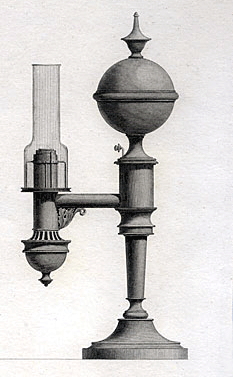 Apart
from sunlight, the only light sources available at the time of the magic
lantern’s invention in the 17th century were candles and oil lamps,
which weren’t very inefficient and produced very dim projected images.
The invention of the Argand lamp in the 1790s helped to make the images
brighter. But the invention of limelight, created by heating a piece of
limestone in burning gas until it became incandescent, in the 1820s made
them even brighter, producing a light strong enough to project an image
before thousands of people, leading to large shows by professional
showmen. But it was dangerous. The invention of the intensely bright
electric arc lamp in the 1860s eliminated the need for combustible gases
or hazardous chemicals, and eventually the incandescent electric lamp
further improved safety and convenience, although not brightness. Apart
from sunlight, the only light sources available at the time of the magic
lantern’s invention in the 17th century were candles and oil lamps,
which weren’t very inefficient and produced very dim projected images.
The invention of the Argand lamp in the 1790s helped to make the images
brighter. But the invention of limelight, created by heating a piece of
limestone in burning gas until it became incandescent, in the 1820s made
them even brighter, producing a light strong enough to project an image
before thousands of people, leading to large shows by professional
showmen. But it was dangerous. The invention of the intensely bright
electric arc lamp in the 1860s eliminated the need for combustible gases
or hazardous chemicals, and eventually the incandescent electric lamp
further improved safety and convenience, although not brightness.
Entertainment Led to Education
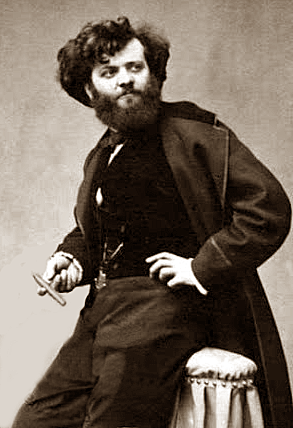 Users
of early magic lanterns intended on scaring their audiences. Pierre
Petit called it "lanterne de peur," the lantern of fear in 1664.
Surviving lantern plates and descriptions from the next several decades
prove that the new medium wasn’t just used for horror shows, but that
people used them to project many kinds of subjects. Users
of early magic lanterns intended on scaring their audiences. Pierre
Petit called it "lanterne de peur," the lantern of fear in 1664.
Surviving lantern plates and descriptions from the next several decades
prove that the new medium wasn’t just used for horror shows, but that
people used them to project many kinds of subjects.
In 1675, Gottfried Wilhelm Leibniz saw an important role for the magic
lantern in his plan for a kind of world exhibition with projections of
"attempts at flight, artistic meteors, optical effects, representations
of the sky with the star and comets, and a model of the earth,
fireworks, water fountains, and ships in rare forms; then mandrakes and
other rare plants and exotic animals."
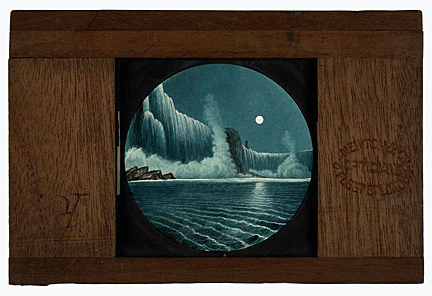 Johannes
Zahn, an early advocate for use of the magic lantern for education, saw
the potential for projecting detailed anatomical illustrations which
were difficult to draw on a chalkboard, but could easily be copied onto
glass or mica. Johannes
Zahn, an early advocate for use of the magic lantern for education, saw
the potential for projecting detailed anatomical illustrations which
were difficult to draw on a chalkboard, but could easily be copied onto
glass or mica.
By the 1730s the use of magic lanterns started to become more widespread
when traveling showmen, conjurers and storytellers added them to their
repertoire. The traveling lanternists, known as Savoyards because they
supposedly came from the Savoy region in France, became a common sight
in many European cities.
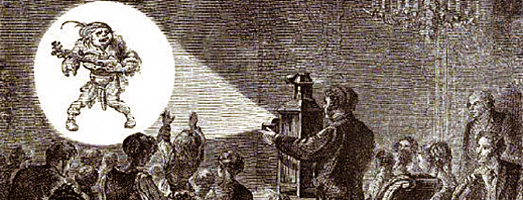
The earliest known “lantern show” in the U. S. occurred in Salem,
Massachusetts, on December 3, 1743, “for the Entertainment of the
Curious.” But the source of light for lanterns in this period—usually
oil lamps—was still weak, and as a consequence the audiences were small.
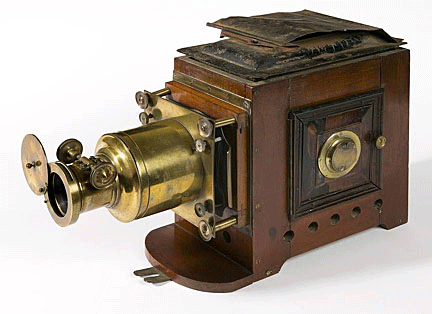 Magic
lanterns had also become a staple of science lecturing and museum events
since Scottish lecturer Henry Moyes’s tour of America between 1785 and
1786, when he recommended that all college laboratories procure one.
French writer and educator Stéphanie Félicité, popularized the use of
magic lanterns as an educational tool in the late 1700s when using
projected images of plants to teach botany. Her educational methods were
published in America in English translation during the early 1820s. Magic
lanterns had also become a staple of science lecturing and museum events
since Scottish lecturer Henry Moyes’s tour of America between 1785 and
1786, when he recommended that all college laboratories procure one.
French writer and educator Stéphanie Félicité, popularized the use of
magic lanterns as an educational tool in the late 1700s when using
projected images of plants to teach botany. Her educational methods were
published in America in English translation during the early 1820s.
Phantasmagoria
Phantasmagoria was a form of horror theater that used one or more magic
lanterns to project frightening images, especially of ghosts. Showmen
used rear projection, mobile or portable projectors and a variety of
effects to produce convincing necromantic experiences. It was very
popular in Europe from the late 18th century to well into the 19th
century. Etienne-Gaspard Robert became famous for his Fantasmagorie show
in Paris from 1798 to 1803
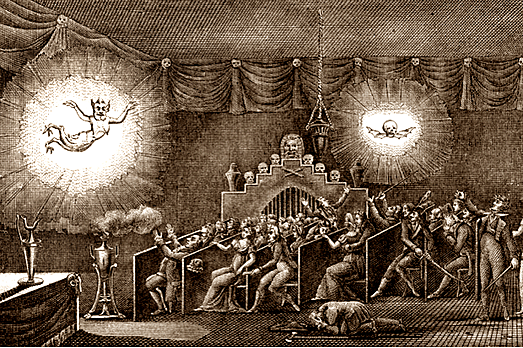
Mass Slide Production
 In
1821, Philip Carpenter's London company, which became Carpenter and
Westley after his death, started manufacturing a sturdy but lightweight
and transportable "Phantasmagoria lantern" with an Argand style lamp. It
produced high quality projections and was suitable for classrooms.
Carpenter also developed a "secret" copper plate printing/burning
process to mass-produce glass lantern slides with printed outlines,
which were then easily and quickly hand painted ready for sale. Known as
"copper-plate sliders," they contained three or four very detailed
4-inch circular images mounted in thin hardwood frames. The first known
set, “The Elements of Zoology,” with over 200 images in 56 frames of
zoological In
1821, Philip Carpenter's London company, which became Carpenter and
Westley after his death, started manufacturing a sturdy but lightweight
and transportable "Phantasmagoria lantern" with an Argand style lamp. It
produced high quality projections and was suitable for classrooms.
Carpenter also developed a "secret" copper plate printing/burning
process to mass-produce glass lantern slides with printed outlines,
which were then easily and quickly hand painted ready for sale. Known as
"copper-plate sliders," they contained three or four very detailed
4-inch circular images mounted in thin hardwood frames. The first known
set, “The Elements of Zoology,” with over 200 images in 56 frames of
zoological
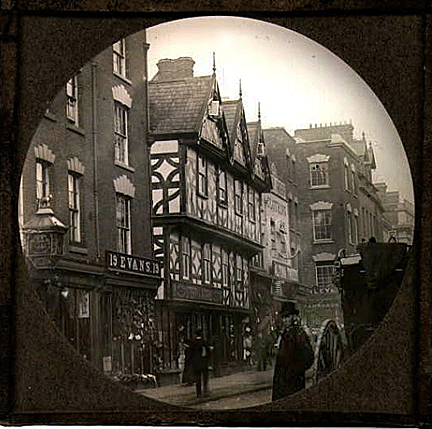 figures,
classified according to the system of the Swedish scientist Carl
Linnaeus, became available in 1823. The same year many other slides
appeared in the company's catalog, including "The Kings and Queens of
England," "Astronomical Diagrams and Constellations," "Views and
Buildings," and “Ancient and Modern Costume.” Even though the category
of "Humorous" provided some entertainment, the focus on education was
obvious. figures,
classified according to the system of the Swedish scientist Carl
Linnaeus, became available in 1823. The same year many other slides
appeared in the company's catalog, including "The Kings and Queens of
England," "Astronomical Diagrams and Constellations," "Views and
Buildings," and “Ancient and Modern Costume.” Even though the category
of "Humorous" provided some entertainment, the focus on education was
obvious.
The mass production of slides also made the magic lantern affordable to
the public, opening a market for smaller lanterns with smaller glass
sliders, which instead of wooden frames usually had colorful strips of
paper glued around their edges.
Waning Popularity
The popularity of magic lanterns waned after the introduction of movies
in the 1890s, but they remained a common medium until slide projectors
became widespread during the 1950s.
< Back
to Collectibles Archives
Next Article > |
